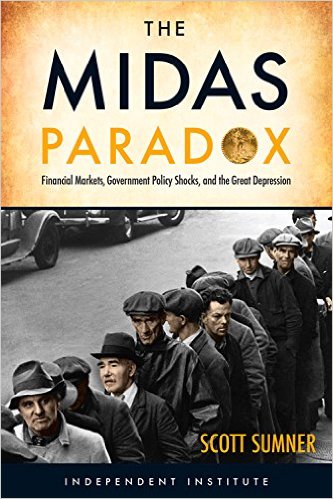Revisiting the Great Depression
By Arnold Kling

The Great Depression of the 1930s is one of the most significant events in economic history. It had an impact not only on the people who lived through it but on economic theory and policy all the way to the present. I believe there is a strong case in favor of requiring every economics graduate student to take a course on the Great Depression. Furthermore, the reading list for such a course definitely ought to include Scott Sumner’s new book, The Midas Paradox: Financial Markets, Government Policy Shocks, and the Great Depression.1 Its title pertains to the role that Sumner assigns to gold hoarding in triggering the Depression.
One can think of Sumner’s book as having three main components, each with valuable insights. First, there is the theoretical framework that he employs to interpret macroeconomic phenomena. Next, there is a narrative of the unfolding of the Depression, using his framework. Finally, there are his comments on other frameworks, including those of John Maynard Keynes in The General Theory of Employment, Interest, and Money and Milton Friedman and Anna Schwartz in A Monetary History of the United States, as well as numerous modern scholars.
Sumner’s theoretical framework starts with a straightforward explanation for fluctuations in employment and output. Large shortfalls in output and employment occur when relatively flexible prices fall in relation to relatively sticky wages. When firms face high wages and low prices, they have to cut back on employment and output.
Higher wages can come from policy shocks. For example, a law that increases the minimum wage will push up wages and reduce employment and output.
Large price movements come from monetary shocks. Lower prices can come from a contractionary monetary policy by the central bank or from fear-driven money hoarding by the private sector.
Sumner’s framework has monetary shocks operating through financial markets. What he terms “market monetarism” differs from the traditional monetarism of Milton Friedman. In Sumner’s view, it is not the past levels of the money supply or the interest rate that are significant. Instead, what matters is the market’s perception of the likely path of monetary policy in the future. As he puts it,
The most important factor influencing the current level of aggregate demand is the expected future path of aggregate demand.
If investors believe that the future path of monetary policy is expansionary, then they will immediately start to bid up prices for sensitive commodities. This means that if the central bank sends a credible signal today that it will maintain an expansionary stance going forward, this can quickly raise prices relative to wages, leading to a rapid expansion of employment and output. Conversely, if an increase in the money supply today is not accompanied by an indication that the expansion will persist, it will have very little effect.
For more on these topics, see the EconTalk podcast episodes with Scott Sumner, Sumner’s EconLog blog posts, and EconTalk podcast discussions on Business Cycles, Recessions, and the Great Depression.
Finally, Sumner sees monetary policy as operating differently under a gold standard than under a fiat money regime. Except for one brief period, from early 1933 to the latter part of 1934, the United States was on a gold standard. The difference was that the price of gold was $20.67 an ounce as of early 1933 and $35 as of late 1934, when the gold standard resumed its role. Sumner focuses on the hoarding of gold during the gold-standard years and on the effect of the dollar devaluation that took place during the interim.
Turning to Sumner’s narrative, permit me some poetic license as I furnish a timeline, using my own nomenclature that I hope is in the spirit of his analysis.
1929-1930 Government Gold Grab. Central banks that gained gold, particularly France and the United States, should have expanded currency in compliance with the gold standard, but failed to do so. This government hoarding of gold caused a large decline in the world money supply, triggering sharp drops in prices and production. As Sumner puts it,
World monetary policy (as measured by changes in the gold reserve ratio) was stable between June 1928 and October 1929, and then tightened sharply over the following twelve months. It was this policy switch, perhaps combined with bearish sentiment from the reduced prospects for international monetary coordination, which triggered a sharp decline in aggregate demand.
1931-1932 Currency Clinging. In response to deteriorating economic conditions and major currency crises, households and firms began to hoard money, in the form of both gold and currency. Without offsetting changes in monetary policy, this caused further deflation. Sumner writes,
… currency hoarding can explain nearly all of the deflation after October 1930. Nominal currency demand actually rose by about 5 percent between October 1930 and the end of 1932, despite a 25 percent drop in the world price level.
March-July 1933 Roosevelt Revival. Upon taking office, President Franklin D. Roosevelt jettisoned the gold standard and signaled an inflationary monetary policy. Says Sumner,
By reducing the gold value of the dollar, FDR dramatically changed expectations about the future course of monetary policy. This immediately raised the prices in equity and commodity markets. Changing the definition of the currency unit really is a foolproof way out of a liquidity trap.
As a result,
This program was unique in U.S. history and was the primary factor behind both the 57 percent surge in industrial production between March and July 1933 and the 22 percent rise in the wholesale price level in the twelve months after March 1933. The initial recovery was triggered not by a preceding monetary expansion, but rather by expectations of future monetary expansion.
July 1933-June 1935 Roosevelt Regression. Unfortunately, another key New Deal initiative offset many of the beneficial effects of the dollar devaluation. This was the corporatist National Industrial Recovery Act, which delivered an adverse wage shock.
After the President’s Re-employment Agreement (better known as the “Blue Eagle” program) was enacted in July 1933, the average nominal wage rate rose by an astounding 22.3 percent in just two months.
… between July 1933 and July 1935 industrial production actually declined. And as late as July 1940, more than seven years after the recovery began, the nonfarm unemployment rate is estimated to have been between 14 and 21 percent!
Mid 1935-Late 1937 Uncertain Upturn. Helped by reduced hoarding of gold, output and employment registered increases. However, New Deal policies continued to raise wages. For the 1930s as a whole,
[o]n five different occasions, the aggregate nominal wage rate rose significantly, each time in response to policies enacted by the Roosevelt administration. And each of these five wage shocks aborted promising recoveries that were underway.
Late 1937-Mid 1938 Depressing Downturn. Perhaps because of worries about the European political situation, gold hoarding resumed, leading to another round of deflation and cuts in production and employment.
… a surge in private gold hoarding is the most plausible explanation for the sharp break in the economy that occurred during the fall of 1937.
“Sumner tells a tale not of one long slump but of a series of contractions and abortive recoveries…”
Overall, this is a much richer narrative than what one finds in basic history texts. Sumner tells a tale not of one long slump but of a series of contractions and abortive recoveries, reflecting the interplay of monetary shocks and wage-policy shocks.
One of Sumner’s main objectives is to challenge other interpretive frameworks that have arisen in the aftermath of the Great Depression. He is especially pointed in his criticism of Keynes and others for seeing a liquidity trap at work, meaning that the public’s demand for money was so extreme that no amount of monetary expansion could alleviate the shortfall in output and employment. Sumner traces the idea of the liquidity trap to the experience in early 1932, in which open-market purchases by the Federal Reserve were not effective in expanding the economy. Sumner writes,
In many respects, the period from April to July 1932 represented the worst three months of the entire Depression… the impact of the open market operations was mostly negated by gold outflows… It is ironic that the only real-world example of a liquidity trap in the entire General Theory actually shows something very different, the constraints imposed on policymakers by the international gold standard.
See Great Depression, by Gene Smiley, Gold Standard, by Michael D. Bordo, and Phillips Curve, by Kevin D. Hoover in the Concise Encyclopedia of Economics.
Sumner’s point is that it was the gold outflow, not the public demand for money, which neutralized the open-market purchases.
Sumner believes that the indicators used by Keynesians to interpret the economy, such as interest rates and a stable Phillips Curve, are more likely to apply in an economy under the gold standard, with fairly stable long-term prices.
No sooner had the United States shifted to a fiat money regime [in 1968] than it began to experience increases in the expected rate of inflation, higher nominal interest rates, and rightward shifts in the Phillips Curve.
Sumner attributes the poor performance in the U.S. economy since mid-2008 to the Fed’s reliance on these inappropriate indicators of the stance of monetary policy. In his view, just as in the Great Depression, policy makers failed to see that tight money was the cause of economic distress. Moreover, I would add that, just as in the Great Depression, many economic pundits are suggesting that wages are too low and advocating a higher minimum wage even though employment-population ratios have yet to recover to pre-recession trend levels.
Although I highly recommend The Midas Paradox, I did not find it entirely persuasive. I worry that it relies too much on Sumner’s reading of the link between wages, prices, and output. My concerns are these:
- 1. The price index that Sumner uses is the Wholesale Price Index. This is a volatile index that largely excludes finished goods and instead tracks goods that are intermediate inputs to other producers. From the standpoint of those final-goods producers, an increase in the WPI indicates not a positive demand shock but an adverse supply shock. Sumner did not succeed in convincing me that the causality runs from increases (decreases) in the WPI to increases (decreases) in output, rather than the other way around.
- 2. For the past 60 years or so, the cyclical behavior of real wages has not been consistent. In fact, on average, real wages have risen at least as rapidly during recoveries as during recessions.
In my own somewhat idiosyncratic opinion, where macroeconomic thinking goes wrong is in treating the entire economy as if it were a single firm. This limits the possible margins of adjustment in the economy to crude aggregates, involving “the” real wage and “the” level of employment. Instead, I think it is important to remember that economic activity is divided into millions of different specialized tasks, and that most of the shocks to which the economy must adjust are localized shifts in relative demands and supplies. These take place as consumers change their tastes, entrepreneurs introduce new products and production processes, and the Schumpeterian process of creative destruction plays out.
Scott Sumner, The Midas Paradox: Financial Markets, Government Policy Shocks, and the Great Depression. Independent Institute, 2015. Available at Amazon.
For more articles by Arnold Kling, see the Archive.

